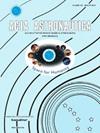Mathematical modeling of nonequilibrium combustion processes in a liquid rocket engine
IF 3.1
2区 物理与天体物理
Q1 ENGINEERING, AEROSPACE
引用次数: 0
Abstract
The key problems of safety for Space missions begin with safety, reliability and effectiveness of rocket engines of different types used at different launch stages and orbit corrections. Today, the possibilities for improving chemical rocket engines of traditional types are almost completely exhausted and are limited to minor improvements in energy-mass characteristics. A qualitative leap in the development of engine building can only be achieved through the development and implementation of new types of engines. As unburned fuel in the combustion chamber is a loss of thrust for the engine, the study of droplet combustion and evaporation, in particular, the droplet lifetime, is of fundamental importance in the creation of combustion chambers using atomized liquid fuel in their operation.
In this paper a quasi-stationary model, which describes the evaporation of a single droplet in a gaseous atmosphere, is presented. Since in the numerical implementation the mass flow from the liquid phase to the gas and the heat flux from the droplet to the gas are calculated based on the Peclet number and the droplet surface temperature obtained from the quasi-stationary problem, approximation formulas for these parameters are developed in this paper. As an example, the problems of evaporation of a liquid oxygen droplet in an atmosphere of gaseous hydrogen and a droplet of liquid n-decane in an atmosphere of gaseous oxygen are considered. Formulas for calculation of mass flow and heat flux from liquid phase to gas based on the solution of the droplet evaporation problem are presented. Estimates of droplets lifetime in engine are provided based on developed droplet evaporation models.
液体火箭发动机非平衡燃烧过程的数学建模
空间飞行任务安全的关键问题首先是在不同发射阶段和轨道修正阶段使用的不同类型火箭发动机的安全性、可靠性和有效性。如今,改进传统类型化学火箭发动机的可能性几乎已经耗尽,仅限于在能量-质量特性方面稍作改进。只有开发和使用新型发动机,才能实现发动机制造发展的质的飞跃。由于燃烧室中未燃烧的燃料会损失发动机的推力,因此研究液滴的燃烧和蒸发,特别是液滴的寿命,对于创建使用雾化液体燃料的燃烧室具有根本性的重要意义。由于在数值计算过程中,从液相到气体的质量流量和从液滴到气体的热流量是根据从准稳态问题中获得的佩克莱特数和液滴表面温度计算的,因此本文为这些参数建立了近似公式。例如,考虑了液态氧液滴在气态氢大气中的蒸发问题和液态正癸烷液滴在气态氧大气中的蒸发问题。根据液滴蒸发问题的解决方案,提出了从液相到气相的质量流量和热流量计算公式。根据开发的液滴蒸发模型,估算了液滴在发动机中的寿命。
本文章由计算机程序翻译,如有差异,请以英文原文为准。
求助全文
约1分钟内获得全文
求助全文
来源期刊

Acta Astronautica
工程技术-工程:宇航
CiteScore
7.20
自引率
22.90%
发文量
599
审稿时长
53 days
期刊介绍:
Acta Astronautica is sponsored by the International Academy of Astronautics. Content is based on original contributions in all fields of basic, engineering, life and social space sciences and of space technology related to:
The peaceful scientific exploration of space,
Its exploitation for human welfare and progress,
Conception, design, development and operation of space-borne and Earth-based systems,
In addition to regular issues, the journal publishes selected proceedings of the annual International Astronautical Congress (IAC), transactions of the IAA and special issues on topics of current interest, such as microgravity, space station technology, geostationary orbits, and space economics. Other subject areas include satellite technology, space transportation and communications, space energy, power and propulsion, astrodynamics, extraterrestrial intelligence and Earth observations.
 求助内容:
求助内容: 应助结果提醒方式:
应助结果提醒方式:


